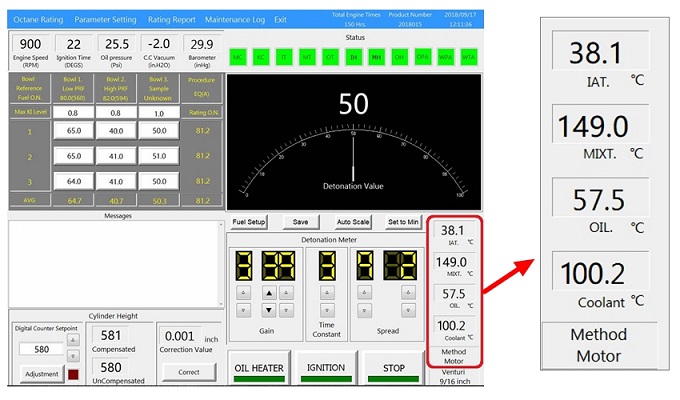For the Octane Rating Unit, the temperature conditions have a great influence on the octane rating operating, especially the intake temperature can directly affect the octane rating results. The key temperature conditions are specified in the ASTM D2699 (RON) and ASTM D2700 (MON) standard, as follows:
| Operating Condition | Temperature | Tolerance |
| Intake Air Temperature* | 52°C(125°F ) at Standard Barometer Base Temperature depends on Barometric Pressure | ±1°C(±2°F) from Base Temperature |
| Crankcase Oil Temperature | 57°C(135°F) | ±8°C(±15°F) |
| Cylinder Coolant Temperature | 100°C(212°F) | ±1.5°C(±3°F) |
NOTE: * Intake air temperature for Research Method octane rating engine can be adjusted 22°C from the base temperature specified for the prevailing barometric pressure, if the temperature is tuned to rate a toluene standardization fuel blend. The temperature must then be maintained within the specified tolerance range. See ASTM D2699 for details.
| Operating Condition | Temperature | Tolerance |
| Intake Air Temperature | 38°C(100°F) | ±2.8°C(±5°F) |
| Crankcase Oil Temperature | 57°C(135°F) | ±8°C(±15°F) |
| Cylinder Coolant Temperature | 100°C(212°F) | ±1.5°C(±3°F) |
| Intake Mixture Temperature* | 149°C(300°F) | ±1°C(±2°F) |
NOTE: * Intake mixture temperature for Motor Method octane rating engine can be adjusted between 141°C(285°F) and 163°C(325°F), if the temperature is tuned to rate a toluene standardization fuel blend. The temperature must then be maintained within the specified tolerance range. See ASTM D2700 for details.

In addition to the above key operating temperature conditions, there are some other temperature conditions that may affect the octane rating results and we should pay attention to them.
Samples Temperature: Samples shall be cooled to a temperature of 2 °C to 10 °C (35 °F to 50 °F), in the container in which they are received, before the container is opened.
Cooling Water System Temperature: The cooling coil in the condenser should be supplied with clean water at a minimum rate of 5.7 L (1.5 gal) per minute, a maximum temperature of 24 °C (75 °F), with a minimum pressure of 276 kPa (40 psi).
Laboratory Temperature: The temperature in the laboratory is suggested to be controlled within the range of 15℃~28℃ and keep relatively stable.